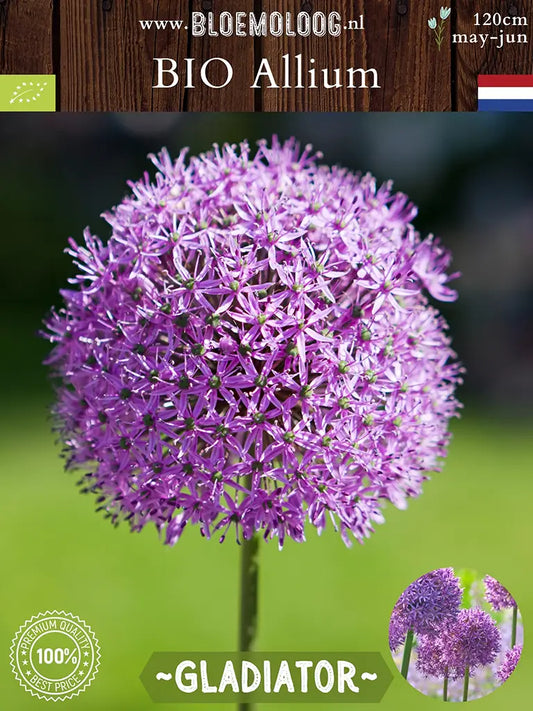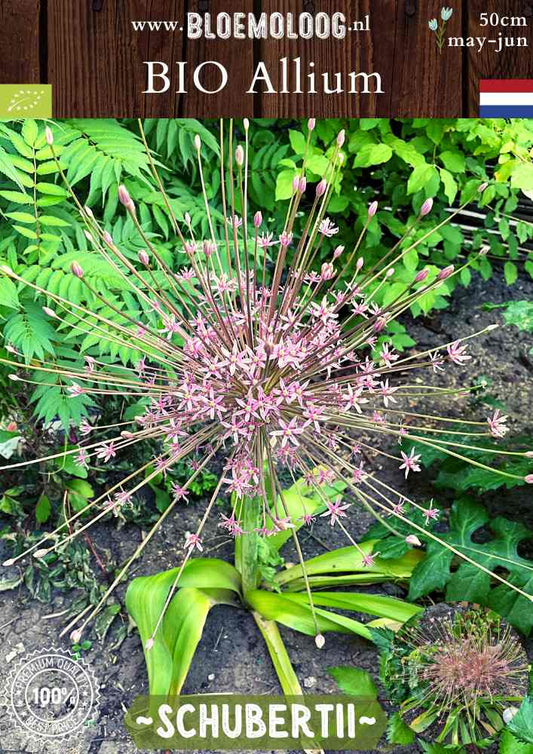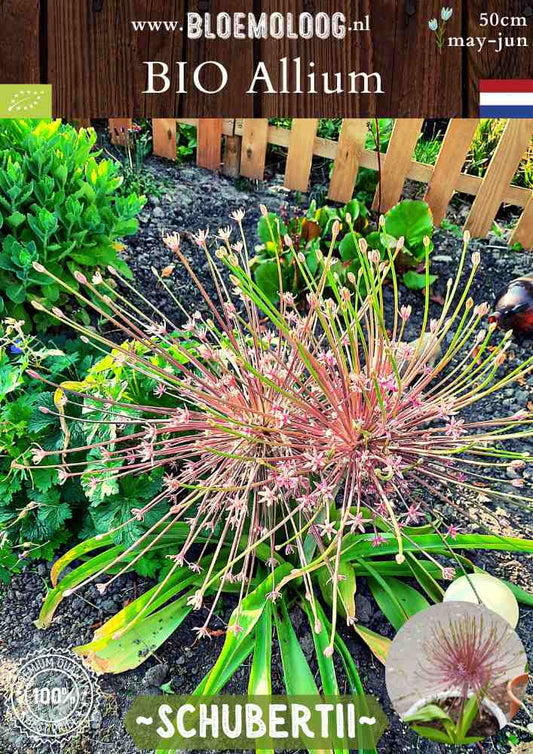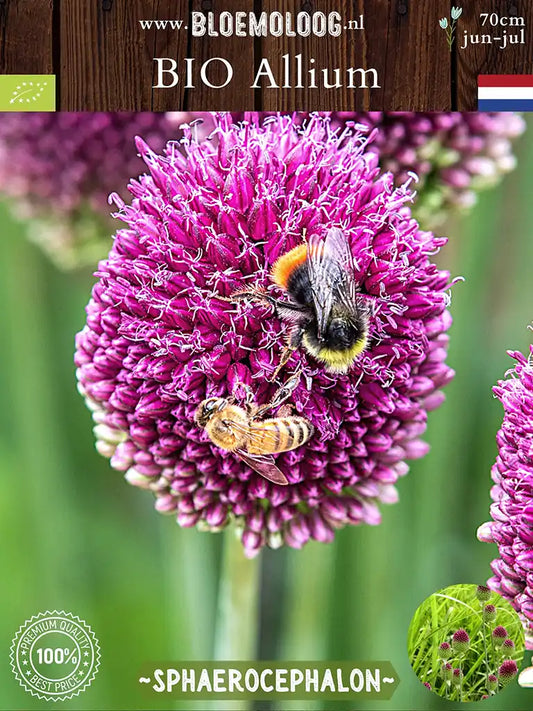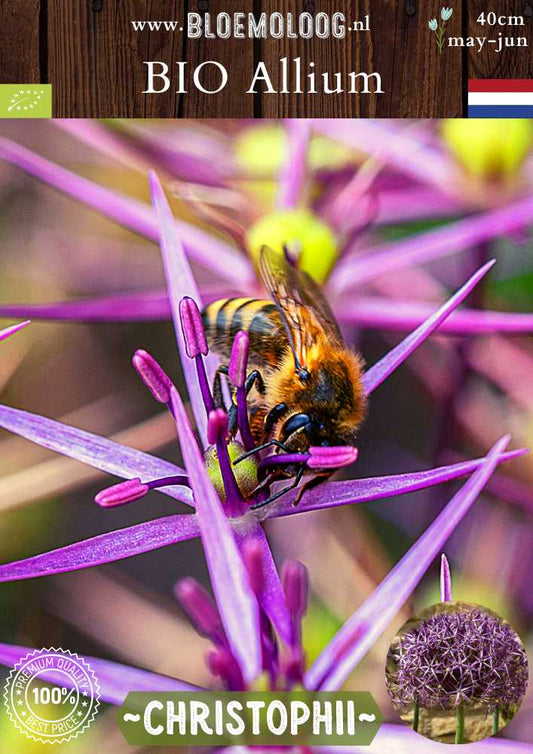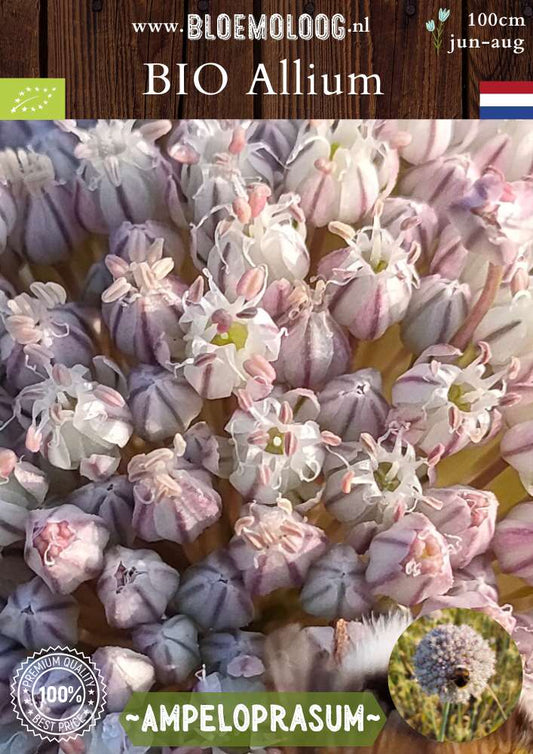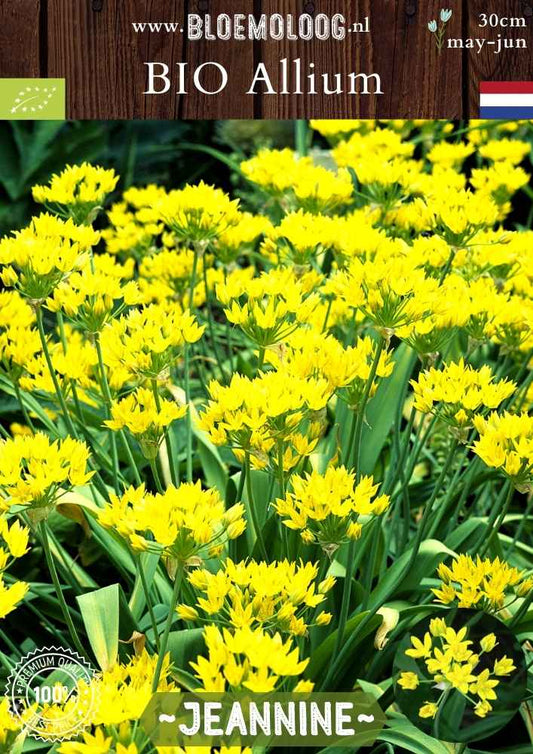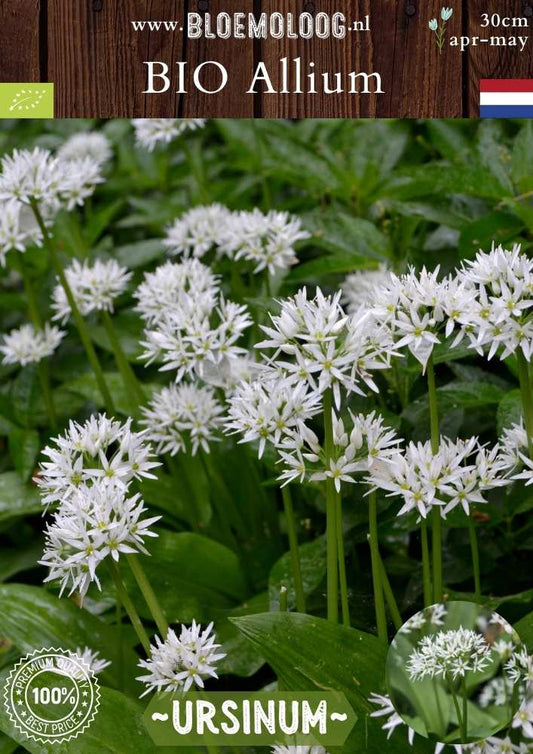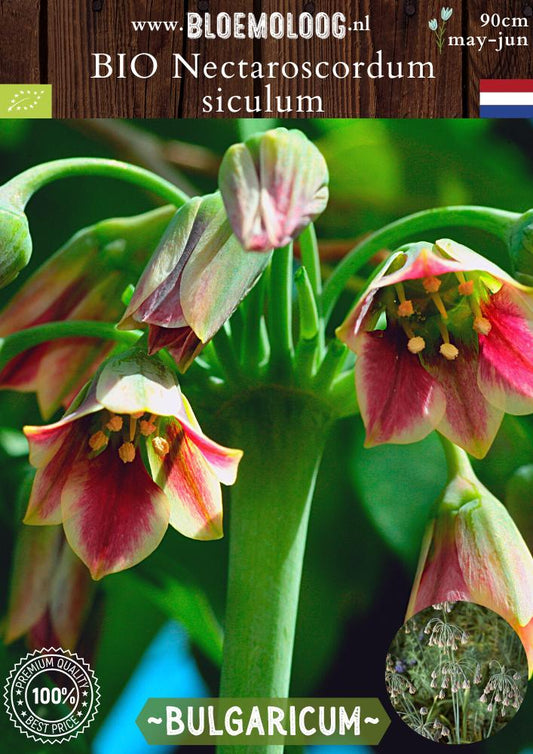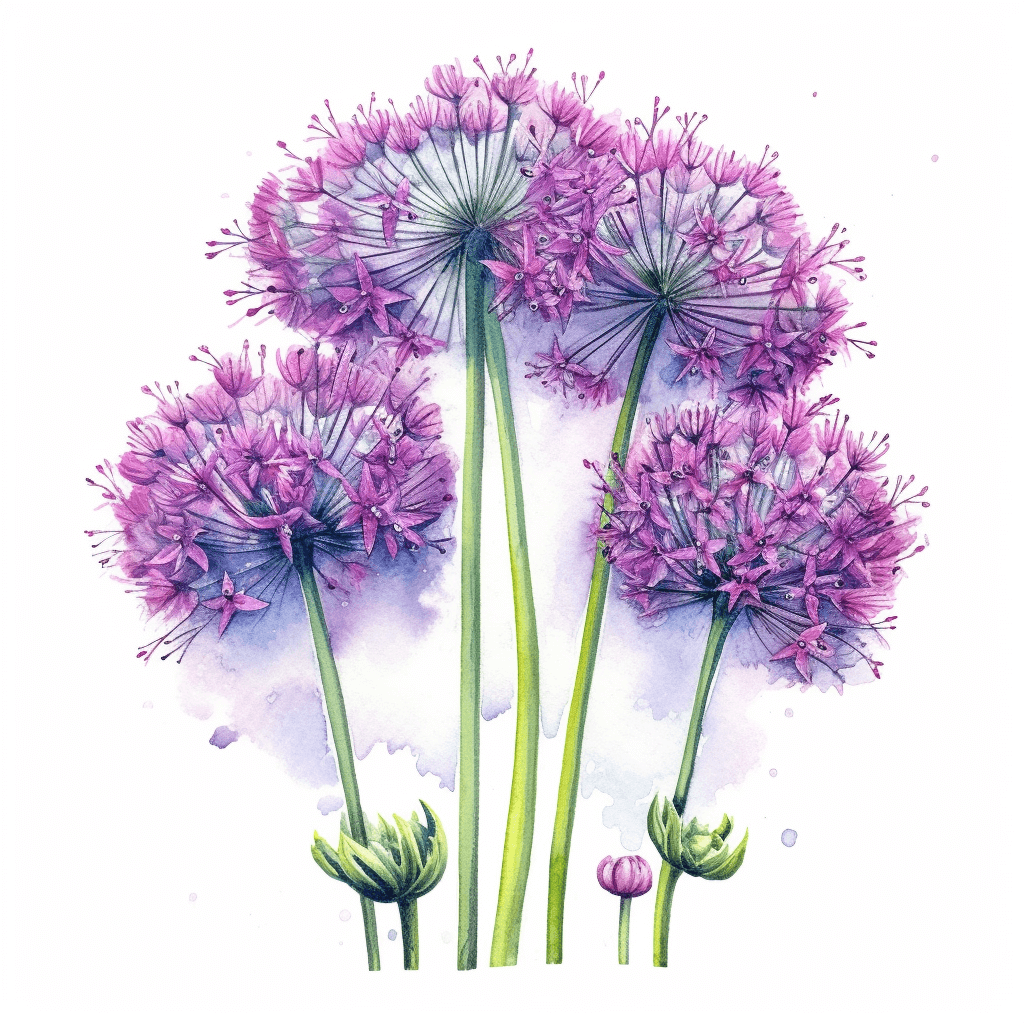
Collection: Organic allium
Organically Grown Allium
The organic alliums offered by Bloemoloog are also known as ornamental onions or flowering onion bulbs. They belong to the allium family (Alliaceae), which also includes garlic and common onions. With over 1,000 different species, including around 100 ornamental varieties, the allium family offers remarkable diversity. Among the most well-known are the vibrant purple 'Purple Sensation' and the elegant white 'Mount Everest'.
These bulbous flowers often form star- or pearl-shaped blooms on tall, sturdy stems. Varieties range from small-flowered types like Allium 'Cowanii' to dramatic, large-flowered types like Allium 'Schubertii'. Many low-growing varieties also return each year to brighten up garden borders. Bloemoloog’s selection includes alliums that range in height from 30 centimeters to one meter.
Organic Alliums for Bees
Ornamental onions are highly attractive to pollinators like bees and butterflies, thanks to their rich supply of nectar and pollen. The deep purple of Allium 'Sphaerocephalon', for instance, is especially enticing to bees, as the plant reflects ultraviolet light, which bees can see. Choosing organically grown alliums supports biodiversity by providing pollinators with a natural and sustainable food source.
Allium as a Host Plant
Some alliums, such as Allium 'Ampeloprasum', can serve as host plants for specific insects like caterpillars or larvae. These plants play a crucial role in insect life cycles by offering food or a safe place to lay eggs. Host plants may also contain essential nutrients or protective compounds that help young insects develop and defend themselves from predators.
Sustainable Flower Bulbs
Ornamental onions are known for their longevity and resilience. Most alliums are perennials, returning year after year to bloom again. Naturalizing varieties are resistant to diseases and produce strong bulbs that store nutrients for the next growing season. Over time, these bulbs multiply and form impressive clusters, adding long-term beauty and structure to your garden.
How, Where, and When to Plant Allium
Most allium bulbs are spring bloomers. Since they are cold germinators, they need a period of cold. Plant them between October and January, ideally in clusters, in well-drained soil. A sunny to partially shaded spot is preferred. The planting depth should be two to three times the bulb’s height, with spacing set at two to three times the bulb’s width.
Some species, such as Allium 'Tuberosum' (also known as garlic chives), are perennial herbs with a root system instead of a bulb. These can be planted in spring and will often flower in the same year. Specific planting instructions are available on each product page.
Caring for Alliums
Once established, ornamental onions are hardy and drought-tolerant. After flowering, you can remove the faded flower stems, but it’s best to leave the foliage intact so the bulb can store energy for the next blooming season. In summer, bulbs can be dug up for propagation. Separate the offsets and replant them in October for new growth the following year.
Where to Buy Organic Allium Bulbs
From June to January, you can order organic allium bulbs from Bloemoloog. Deliveries begin in September, aligned with the planting season. From August to January, bulbs can also be purchased directly from our market stall. Visit one of our markets to choose your bulbs in person.
Buy Organic Garlic Chives
Allium 'Tuberosum', also known as garlic chives or Chinese chives, can be ordered from January to June in the Summer Bloomers category. From March to June, while supplies last, you can also pick them up at one of our markets.
-
Organic Allium 'Cowanii' - White ornamental onion | 10 pcs.
Regular price CHF 5.00Regular priceUnit price CHF 0.50 / per item -
Organic Allium 'Gladiator' - Giant ornamental onion
Regular price CHF 4.00Regular priceUnit price / per -
Organic Allium 'Mount Everest' & 'Purple Sensation' mix | 6 pcs.
Regular price CHF 10.00Regular priceUnit price CHF 1.67 / per item -
Organic Allium 'Mount Everest' - White ornamental onion | 3 pcs.
Regular price CHF 6.00Regular priceUnit price CHF 2.00 / per item -
Organic Allium 'Purple Sensation' - Dutch garlic | 5 pcs.
Regular price CHF 6.00Regular priceUnit price CHF 1.20 / per item -
Organic Allium 'Purple Sensation' XL - Dutch garlic | 3 pcs.
Regular price CHF 6.00Regular priceUnit price CHF 2.00 / per item -
Organic Allium 'Schubertii' - Persian ornamental onion
Regular price CHF 4.00Regular priceUnit price / per -
Organic Allium 'Schubertii' XL - Persian ornamental onion
Regular price CHF 5.00Regular priceUnit price / per -
Organic Allium 'Sphaerocephalon' - Drumsticks | 10 pcs.
Regular price CHF 5.00Regular priceUnit price CHF 0.50 / per item -
Organic Allium albopilosum 'Christophii' - Persian onion | 3 pcs.
Regular price CHF 6.00Regular priceUnit price CHF 2.00 / per item -
Organic Allium ampeloprasum 'Ping Pong' - Pearl onion | 10 pcs.
Regular price CHF 5.00Regular priceUnit price CHF 0.50 / per item -
Organic Allium moly 'Jeannine' - Golden Garlic | 10 pcs.
Regular price CHF 5.00Regular priceUnit price CHF 0.50 / per item -
Organic Allium ursinum - Wild garlic | 5 pcs.
Regular price CHF 7.00Regular priceUnit price CHF 1.40 / per item -
Organic Nectaroscordum siculum 'Bulgaricum' - Bulgarian ornamental onion | 6 pcs.
Regular price CHF 5.00Regular priceUnit price CHF 0.83 / per item
-
Organic spring bulbs
Spring-flowering bulbs and tubers are popular plants that produce beautiful flowers from early spring through summer. Because of their early bloom, they combine well with perennials when they still need to establish themselves.
Tulips are probably the most well-known spring flowers. They come in many different colors, shapes, and sizes. Daffodils are known for their cheerful yellow flowers, but they also come in other colors like white and orange. Crocuses are small bulbous plants with striking flowers in shades of purple, yellow, and white. They are often the first flowers to appear in spring. Hyacinths have fragrant flowers in various colors, such as pink, purple, blue, and white. They are often planted in borders, flower beds, or pots.Benefits of organic spring bulbs
When you choose organic flower bulbs that bloom in spring, you can be sure that no chemicals or pesticides will end up in your garden. These pesticides are harmful to bees and prevent them from finding their nests. As a result, more and more bee species have been added to the red list in recent years. Together, we can do something about this!
Flower bulbs for wild bees
Did you know that wild bees lay eggs in their nests, which then hatch in early spring? These newborn insect helpers immediately search for food in the surrounding area. There are also insects that have hibernated and are desperately looking for a hearty breakfast: the blooming flowers where nectar and pollen can be found! Just after winter, there's little greenery or food for these insects. Planting early-blooming flower bulbs ensures there's food available, and the insects can gain strength for the coming summer.
Organic growers
The organic growers we work with cultivate not only the most beautiful but also the strongest products. They cultivate varieties and species of flowers and plants that experience has shown to be virus-resistant, so they don't need to use chemicals and pesticides. Organic growers seek natural remedies and solutions against diseases and/or pests. All our flower bulbs are certified organic; both the Florist and the growers are SKAL-certified.
When do you plant spring bulbs?
Spring-flowering bulbs can be planted from autumn until January. Bulbs that need to be dug up in the summer after flowering should be dug up starting in late July and stored until the next planting season in autumn.
What to do after flowering
When spring bloomers have finished blooming, cut off the wilted flowers at the top of the stem. Let the rest of the plant die back naturally so it can still receive maximum energy from the sun.
How do you store spring bulbs?
If you've purchased flower bulbs from us and had them delivered to your home and would like to leave them for a while, we recommend opening the box and storing it in a ventilated, cool place until you're ready to plant them.
Store flower bulbs you dig up after flowering in a warm place, such as a shed. To prevent mice from eating the bulbs during this period, you can also hang them in a bag or pantyhose. -
Where is the best place to plant spring bulbs?
Spring-flowering bulbs are flowers that bloom in the spring, between January and July. There are many different types of spring-flowering bulbs, suitable for different types of gardens and soil. For example, some bulb plants enjoy catching a glimpse of the sun during flowering, but prefer to be covered by a tree during their dormant period in summer.
Spring bloomers in the sun
Many spring bloomers need plenty of sun to bloom and grow well for the following year. These flowers thrive in full sun:
Spring bloomers in the shade
Some spring bloomers also grow and bloom well in the shade, such as:
Spring bloomers in moist soil types
There are also flower bulbs that can be planted in moist soil. Some varieties from the Florist's collection include:
Conclusion
There are many different types of spring bloomers suitable for different types of gardens and soil. Whether a spring bloomer can grow in sun or shade depends on the specific variety. Some prefer dry soil, while others prefer wet feet. So, there's a suitable spring bloomer for every garden.
Tips for a flowery garden
Plant a variety of flowers, each with its own blooming time, so there are flowers blooming throughout the spring and food for bees and other insects in your garden. Would you also like to arrange your garden/bed so you can enjoy flowers all spring long, and the bees too? Feel free to send us a message or ask us at the market stall. We're happy to help! Promote biodiversity in your garden and enjoy the first flowers and colors after the cold and dark winter!
Order spring bloomers in advance
Pre-sales for spring-flowering bulbs will begin on June 1st in the Bloemoloog webshop.
During the pre-sale, you can pre-order your desired products. This way, you can be sure your favorite flowers are still in stock, and we'll ship your package with PostNL as soon as planting time arrives.
Flower bulbs ordered in the pre-sale will be delivered in mid-September. From then on, they can be planted directly in the garden or in containers on the balcony.




